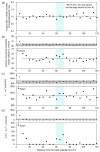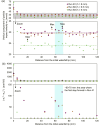Controls on Erosion and Cyclic Step-Formation Upstream of Waterfalls
- PMID: 39582586
- PMCID: PMC11583113
- DOI: 10.1029/2024GL110751
Controls on Erosion and Cyclic Step-Formation Upstream of Waterfalls
Abstract
Waterfall retreat transmits base-level perturbations upstream, thereby providing markers of changing climate and tectonics. In homogeneous rock, waterfalls often retreat either by direct waterfall-face erosion or incision from repeating ('cyclic') steps formed above waterfalls. We lack knowledge on the conditions driving these different erosion styles, limiting our ability to predict waterfall retreat. We address this knowledge gap through flume experiments assessing how changing flow hydraulics modulates bedrock erosion. We show that, under large discharges, changes in flow hydraulics cause spatial variability in particle impact velocity, leading to cyclic step formation. As discharge decreases, both the magnitude and spatial variability of particle impact velocity decreases, causing more uniform erosion, limiting cyclic step development and potentially allowing direct erosion of the waterfall face to become the dominant retreat mechanism. These results suggest climate change and water-resource management can alter the rate and style of waterfall retreat.
Keywords: bedrock; cyclic steps; erosion; waterfall.
© 2024. The Author(s).
Figures




References
-
- Baynes, E. R. C. , Lague, D. , & Kermarrec, J. J. (2018). Supercritical River terraces generated by hydraulic and geomorphic interactions. Geology, 46(6), 499–502. 10.1130/G40071.1h - DOI
-
- Berlin, M. M. , & Anderson, R. S. (2007). Modeling of knickpoint retreat on the roan plateau, western Colorado. Journal of Geophysical Research, 112(F3), F03S06. 10.1029/2006JF000553 - DOI
-
- Bitter, J. G. A. (1963). A study of erosion phenomena, part I. Wear, 6(1), 5–21. 10.1016/0043-1648(63)90003-6 - DOI
LinkOut - more resources
Full Text Sources
Research Materials
Miscellaneous
